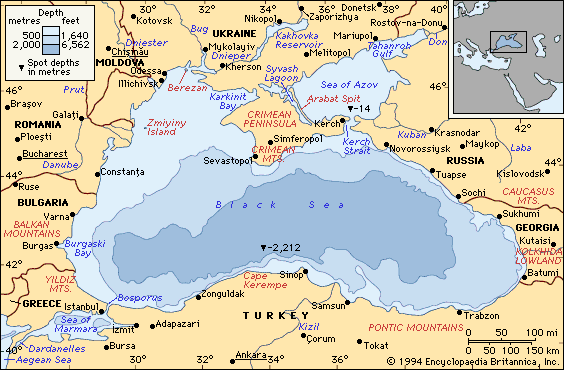Sochi Club |
Your Complete Guide to
|
|
||
|
Evidence found of Noah's ark flood victims |
| Over the years we have
been gathering information and collecting articles about the Black
Sea, which we are glad to share with you here. If you are interested
in activities like diving, sailing etc. please go to our Attractions
pages. These pages are about the history, physical features and
exploration of the Black sea. |
| Ancient Greeks
called it Pontus Euxinus (Hospitable Sea). In the 9th and 10th centuries
AD it was known among the Russians as the Russian sea. There are several
hypotheses of the origin of its present name. Some historians say
that it is a translation of the Turkish Karadeniz, which means "black,
inhospitable sea". The Turks and other conquerors of its shores
associated the sea with the bitter resistance by the local population. Another theory comes from hydrologists. The name, they assume, reflects the Black sea's unique ability to tint black metal objects that get deep down into it - the action of strong concentrations of hydrogen sulfide. The sea surface gets intensely heated by the sun, and has no time to cool down during short winter, so the surface water scarcely penetrates lower down to the depths. These deeper waters, because of absence of oxygen flow from the surface, contain no life. |
|
|
The Black Sea is connected to the distant waters of the Atlantic Ocean by the succession of the Bosporus (a strait at the Black Sea's southwestern corner), the Sea of Marmara, the Dardanelles, the Aegean Sea, and the Mediterranean Sea. The peninsula of Crimea extends into the sea from the north, and immediately to the east the narrow Kerch Strait opens onto the smaller Sea of Azov. The Black Sea's water-surface area is about 178,000 square miles (461,000 square km), and its maximum depth is more than 7,250 feet (2,210 m). The Black Sea has few coastal lowlands. The Danube, Dnieper, Dniester, and Don are the largest rivers emptying into the sea. The Black Sea is a residual basin of the ancient Tethys Sea; its present form probably emerged about 58 million years ago when structural upheavals in Anatolia split off the Caspian basin from the Mediterranean. The newly formed Black Sea basin gradually became isolated from the ocean, its salinity was reduced, and it was slowly separated from the Caspian region. The salinity of the Black Sea is almost half that of the world's oceans. An unusual feature of the Black Sea is that oxygen is dissolved only in the upper levels of its waters, which alone can support a rich sea life as a result. Below a depth of 230–330 feet (70–100 m) at the centre and 330–500 feet (100–150 m) near the sea's margins, there is no oxygen because the sea is permeated by a high concentration of dissolved hydrogen sulfide, forming a saturated, “dead” zone inhabitable only by specially adapted bacteria. Despite this anomaly, the Black Sea's uppermost waters supported abundant sturgeon, mackerel, and anchovy until the late 20th century, when the runoff of industrial and municipal wastes into the Danube, Dnieper, and other feeder rivers caused increasing levels of pollution and consequent reductions in fish populations. The roughly oval-shaped Black Sea occupies a large basin strategically situated at the southeastern extremity of Europe but connected to the distant waters of the Atlantic Ocean by the Bosporus (which emerges from the sea's southwestern corner), the Sea of Marmara, the Dardanelles, the Aegean Sea, and the Mediterranean Sea. The renowned Crimean Peninsula thrusts into the Black Sea from the north, and just to its east the narrow Kerch Strait links the sea to the smaller Sea of Azov. The Black Sea coastline is otherwise fairly regular. The maximum east-west extent of the sea is about 730 miles (1,175 kilometres), while the shortest distance between the tip of the Crimea and the Kerempe Burmi Cape to the south is about 160 miles. The surface area, excluding the Sea of Marmara but including the Sea of Azov, is about 178,000 square miles (461,000 square kilometres); the Black Sea proper occupies about 163,000 square miles (422,000 square kilometres). A maximum depth of more than 7,250 feet (2,210 metres) is reached in the south-central sector of the sea. In ancient Greek myths, the sea—then on the fringe of the Mediterranean world—was named Pontus Axeinus, meaning “Inhospitable Sea.” Later explorations made the region more familiar, and, as colonies were established along the shores of a sea the Greeks came to know as more hospitable and friendly, its name was changed to Pontus Euxinus, the opposite of the earlier designation. It was across its waters that Jason and the Argonauts set out, according to legend, to find the Golden Fleece in the land of Colchis, a kingdom at the sea's eastern tip (now Georgia). The Turks, when they came to control the lands beyond the sea's southern shores, encountered only the sudden storms whipped up on its waters and reverted to a designation reflecting the inhospitable aspect of what they now termed the Karadeniz, or Black Sea. To scientists the Black Sea is a remarkable feature because its lower levels are, to all intents and purposes, almost biologically dead—not because of modern pollution but because of continued weak ventilation of the deep layers. To the nations of the region, the Black Sea has been of immense strategic importance over the centuries; the advent of more settled conditions has brought its economic importance to the fore. |
|
Sochi Club 1998-2003 |

